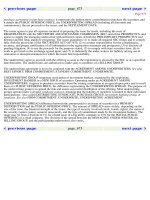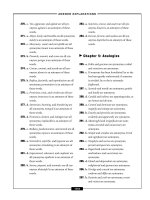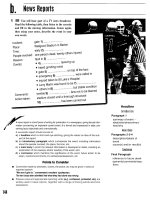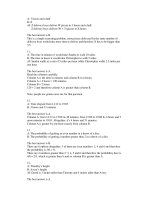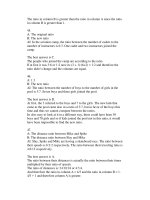problems practice phần 10 ppsx
Bạn đang xem bản rút gọn của tài liệu. Xem và tải ngay bản đầy đủ của tài liệu tại đây (98.92 KB, 19 trang )
2. Water has been poured into an empty rectangular tank at the rate of 8 cubic feet per
minute for 2.5 minutes. The length of the tank is 3 feet and the width is one half of the
length. Approximately how deep is the water in the tank?
(a) 3.23 feet
(b) 3.86 feet
(c) 4 feet
(d) 4.25 feet
(e) 4.44 feet
3. What is the sum of 11 consecutive integers?
(1) The median of the 11 integers is 6.
(2) The average of the 11 integers is 6.
(a) Statement (1) BY ITSELF is sufficient to answer the question, but statement (2)
by itself is not.
(b) Statement (2) BY ITSELF is sufficient to answer the question, but statement (1)
by itself is not.
(c) Statements (1) and (2) TAKEN TOGETHER are sufficient to answer the question,
even though NEITHER statement BY ITSELF is sufficient.
(d) Either statement BY ITSELF is sufficient to answer the question.
(e) Statements (1) and (2) TAKEN TOGETHER are NOT sufficient to answer the
question, requiring more data pertaining to the problem.
4. X, Y and Z are three positive integers. If Z = 2, what is their sum?
X – Y = 5.
3Y + 15 = 3X.
(a) Statement (1) BY ITSELF is sufficient to answer the question, but statement (2)
by itself is not.
(b) Statement (2) BY ITSELF is sufficient to answer the question, but statement (1)
by itself is not.
(c) Statements (1) and (2) TAKEN TOGETHER are sufficient to answer the question,
even though NEITHER statement BY ITSELF is sufficient.
(d) Either statement BY ITSELF is sufficient to answer the question.
(e) Statements (1) and (2) TAKEN TOGETHER are NOT sufficient to answer the
question, requiring more data pertaining to the problem.
5. Roy is now 4 years older than Erik and half of that amount older than Iris. If in 2
years, Roy will be twice as old as Erik, then in 2 years what would be Roy’s age
multiplied by Iris’s age?
(a) 8
(b) 28
(c) 48
(d) 50
(e) 52
6. An investment yields an interest payment of $228 each month. If the simple annual
interest rate is 9%, what is the amount of the investment?
(a) $28,300
(b) $30,400
(c) $31,300
(d) $32,500
(e) $35,100
7. In a rectangular coordinate system, what approximately is the area of a circle whose
center is at (5, 5) and a point on its circumference is at (8, 9)?
(a) 60
(b) 63
(c) 68 (8,9)
(d) 79 (5,5)
(e) 82
8. x, y, z, and w are integers. The expression x-y-z is even and the
Expression y-z-w is odd. If x is even what must be true?
y-z must be odd.
w must be even.
w must be odd.
z must be even.
Z must be odd
9. X is a prime number bigger than 10. Also, Y = X+X
3
+X
5
+X
7
.
What is definitely true about Y?
Y is a prime number.
Y is odd.
Y is even.
Y can be divided equally by 3.
Y can be divided equally by 7.
10. Is Y even?
2Y is even.
Y
2
is even.
(a) Statement (1) BY ITSELF is sufficient to answer the question, but statement (2)
by itself is not.
(b) Statement (2) BY ITSELF is sufficient to answer the question, but statement (1)
by itself is not.
(c) Statements (1) and (2) TAKEN TOGETHER are sufficient to answer the question,
even though NEITHER statement BY ITSELF is sufficient.
(d) Either statement BY ITSELF is sufficient to answer the question.
(e) Statements (1) and (2) TAKEN TOGETHER are NOT sufficient to answer the
question, requiring more data pertaining to the problem.
11. If A is a prime number, what is the value of A?
0 < A < 10.
(A – 2) is divisible by 3.
(a) Statement (1) BY ITSELF is sufficient to answer the question, but statement (2)
by itself is not.
(b) Statement (2) BY ITSELF is sufficient to answer the question, but statement (1)
by itself is not.
(c) Statements (1) and (2) TAKEN TOGETHER are sufficient to answer the question,
even though NEITHER statement BY ITSELF is sufficient.
(d) Either statement BY ITSELF is sufficient to answer the question.
(e) Statements (1) and (2) TAKEN TOGETHER are NOT sufficient to answer the
question, requiring more data pertaining to the problem.
12.
X and Y are two sides of a triangle, is the area of the triangle an integer?
X is a prime number.
Y is an odd integer.
(a) Statement (1) BY ITSELF is sufficient to answer the question, but statement (2)
by itself is not.
(b) Statement (2) BY ITSELF is sufficient to answer the question, but statement (1)
by itself is not.
(c) Statements (1) and (2) TAKEN TOGETHER are sufficient to answer the question,
even though NEITHER statement BY ITSELF is sufficient.
(d) Either statement BY ITSELF is sufficient to answer the question.
(e) Statements (1) and (2) TAKEN TOGETHER are NOT sufficient to answer the
question, requiring more data pertaining to the problem.
X
Y
13. In Tukitu village, one forth of the people are raising flowers, one ninth are
growing wheat and one eleventh are going bankrupt.
What could be the number of people in the village?
792.
540.
198.
132.
346
14. Q is a prime number bigger than 10. What is the smallest positive number (except
1) that 3Q can be divided by equally?
3Q.
Q
3
Q+3
2Q
15. 35
2
- 34
2
=?
35 – 34.
35 + 34.
35
2
.
2 x 35 x 34.
34.
16. In a box there are A green balls, 3A + 6 red balls and 2 yellow ones.
If there are no other colors, what is the probability of taking out a green or a yellow
ball?
1/5.
½.
1/3.
¼.
2/3.
17. A long rope was divided to three different parts. What is the length of the smallest
piece?
The sum of the two smaller pieces is 14 inch.
The sum of the two larger pieces is 22 inch.
(a) Statement (1) BY ITSELF is sufficient to answer the question, but statement (2)
by itself is not.
(b) Statement (2) BY ITSELF is sufficient to answer the question, but statement (1)
by itself is not.
(c) Statements (1) and (2) TAKEN TOGETHER are sufficient to answer the question,
even though NEITHER statement BY ITSELF is sufficient.
(d) Either statement BY ITSELF is sufficient to answer the question.
(e) Statements (1) and (2) TAKEN TOGETHER are NOT sufficient to answer the
question, requiring more data pertaining to the problem.
18. Fuel tanker A can fill the underground reservoir in 12 minutes. How long will it
take fuel tanker A and fuel tanker B to fill up the same reservoir together?
The reservoir contains 3000 liters of fuel.
Fuel tanker B alone will require the same number of hours to fill the same reservoir.
(a) Statement (1) BY ITSELF is sufficient to answer the question, but statement (2)
by itself is not.
(b) Statement (2) BY ITSELF is sufficient to answer the question, but statement (1)
by itself is not.
(c) Statements (1) and (2) TAKEN TOGETHER are sufficient to answer the question,
even though NEITHER statement BY ITSELF is sufficient.
(d) Either statement BY ITSELF is sufficient to answer the question.
(e) Statements (1) and (2) TAKEN TOGETHER are NOT sufficient to answer the
question, requiring more data pertaining to the problem.
19. What is the ratio between A and B?
A is the sum of X, Y and Z.
B is the average (arithmetic mean) of X, Y and Z.
(a) Statement (1) BY ITSELF is sufficient to answer the question, but statement (2)
by itself is not.
(b) Statement (2) BY ITSELF is sufficient to answer the question, but statement (1)
by itself is not.
(c) Statements (1) and (2) TAKEN TOGETHER are sufficient to answer the question,
even though NEITHER statement BY ITSELF is sufficient.
(d) Either statement BY ITSELF is sufficient to answer the question.
(e) Statements (1) and (2) TAKEN TOGETHER are NOT sufficient to answer the
question, requiring more data pertaining to the problem.
20. Kelly used to get a 30% discount on movie tickets. When the price of the movie
ticket increased by 50%, the amount of discount in dollars remained the same. What is
Kelly's discount with the new Ticket price in percent terms?
(a) 10%
(b) 20%
(c) 25%
(d) 35%
(e) 38%
21. Tom divided his cards between Tim and Din so each one received an equal odd
amount of cards. The number of cards that Tim received multiplied by the number of
cards that Din received is a number larger than 49 and smaller than 121. How many
cards did Tom have in the first place?
16.
22.
18.
14.
32.
22. In the beginning of the season, the owner of a football team bought T players for
the price of 4R each. At the end of the season the owner sold the players in a total
profit of X. How much did the owner get for all the players?
X – 4TR.
4X + 4TR.
4TR + X.
4(TR – X).
4TR – X.
23. A bird is flying from an oak tree to a pine tree in a speed of 6 Km/h.
On her way back, she flew at a speed of 4 Km/h, thus, the trip lasted 4 hours more.
What is the distance between the trees? (In Km)
12.
24.
36.
48.
52.
24. If X and Y are both integers different from zero, what is the value of (X + 2Y)?
X
4
= Y
4
.
X = 5.
(a) Statement (1) BY ITSELF is sufficient to answer the question, but statement (2)
by itself is not.
(b) Statement (2) BY ITSELF is sufficient to answer the question, but statement (1)
by itself is not.
(c) Statements (1) and (2) TAKEN TOGETHER are sufficient to answer the question,
even though NEITHER statement BY ITSELF is sufficient.
(d) Either statement BY ITSELF is sufficient to answer the question.
(e) Statements (1) and (2) TAKEN TOGETHER are NOT sufficient to answer the
question, requiring more data pertaining to the problem.
25. Is the square root of A an integer?
The last digit of A is 8.
A is divisible by 6.
(a) Statement (1) BY ITSELF is sufficient to answer the question, but statement (2)
by itself is not.
(b) Statement (2) BY ITSELF is sufficient to answer the question, but statement (1)
by itself is not.
(c) Statements (1) and (2) TAKEN TOGETHER are sufficient to answer the question,
even though NEITHER statement BY ITSELF is sufficient.
(d) Either statement BY ITSELF is sufficient to answer the question.
(e) Statements (1) and (2) TAKEN TOGETHER are NOT sufficient to answer the
question, requiring more data pertaining to the problem.
26. Is the average of X consecutive numbers odd?
The first number in the series is odd.
The sum of the numbers is odd.
(a) Statement (1) BY ITSELF is sufficient to answer the question, but statement (2)
by itself is not.
(b) Statement (2) BY ITSELF is sufficient to answer the question, but statement (1)
by itself is not.
(c) Statements (1) and (2) TAKEN TOGETHER are sufficient to answer the question,
even though NEITHER statement BY ITSELF is sufficient.
(d) Either statement BY ITSELF is sufficient to answer the question.
(e) Statements (1) and (2) TAKEN TOGETHER are NOT sufficient to answer the
question, requiring more data pertaining to the problem.
27. In a chocolate store, there are vanilla and chocolate flavor bon-bons only.
10% of the bon-bons are chocolate flavored, 90% of the rest are squashed.
What percentage of the bon-bons is vanilla flavored that are not squashed?
(a) 1%
(b) 5%
(c) 9%
(d) 10%
(e) 2%
28. A credit card number has 6 digits (between 0 to 9). The first two digits are 12 in
that order, the third digit is bigger than 6, the forth one can be equally divided by 3
and the fifth digit is 3 times bigger than the sixth one. How many credit cards can be
made?
(a) 27.
(b) 36.
(c) 72.
(d) 112.
(e) 422.
29. Out of a box that contains 4 black mice and 6 white ones, three are picked up.
What is the probability that all three will be black mice?
(a) 8/125.
(b) 1/30.
(c) 2/5.
(d) 1/720.
(e) 3/10.
30. A car is driving at 60 Km/h for 20 minutes, and then drives at 90Km/h for another
40 minutes. What is the average speed of the car?
(a) 80.
(b) 75.
(c) 70.
(d) 65.
(e) 54.
31. Two grandfathers can nit a sweater in 6 days. Two grandfathers and one
grandmother can nit a sweater in 3 days. How many days will it take the grandmother
to nit a sweater all by her self?
(a) 4.5.
(b) 5.
(c) 5.5.
(d) 6.
(e) 6.5.
32. If X and Y are integers, what is the value of XY?
X
3
– 3X
2
– 2X – 8 = 0.
4 + 3Y = 2Y + 8.
(a) Statement (1) BY ITSELF is sufficient to answer the question, but statement (2)
by itself is not.
(b) Statement (2) BY ITSELF is sufficient to answer the question, but statement (1)
by itself is not.
(c) Statements (1) and (2) TAKEN TOGETHER are sufficient to answer the question,
even though NEITHER statement BY ITSELF is sufficient.
(d) Either statement BY ITSELF is sufficient to answer the question.
(e) Statements (1) and (2) TAKEN TOGETHER are NOT sufficient to answer the
question, requiring more data pertaining to the problem.
33. If Q and T are integers, what is the value of Q?
Q = 2T/7.
4
)2(7
2
7
QT
(a) Statement (1) BY ITSELF is sufficient to answer the question, but statement (2)
by itself is not.
(b) Statement (2) BY ITSELF is sufficient to answer the question, but statement (1)
by itself is not.
(c) Statements (1) and (2) TAKEN TOGETHER are sufficient to answer the question,
even though NEITHER statement BY ITSELF is sufficient.
(d) Either statement BY ITSELF is sufficient to answer the question.
(e) Statements (1) and (2) TAKEN TOGETHER are NOT sufficient to answer the
question, requiring more data pertaining to the problem.
34. Each of the 850 local villagers in Lucia owns either a Golden Retriever or a
Bernard. How many people own both?
The number of villagers who own a Golden Retriever only is 300.
The number of villagers who own a Bernard only is 280.
(a) Statement (1) BY ITSELF is sufficient to answer the question, but statement (2)
by itself is not.
(b) Statement (2) BY ITSELF is sufficient to answer the question, but statement (1)
by itself is not.
(c) Statements (1) and (2) TAKEN TOGETHER are sufficient to answer the question,
even though NEITHER statement BY ITSELF is sufficient.
(d) Either statement BY ITSELF is sufficient to answer the question.
(e) Statements (1) and (2) TAKEN TOGETHER are NOT sufficient to answer the
question, requiring more data pertaining to the problem.
35. How much is Y percent of X?
(1) 400% of Y is 90.
(2) X percent of Y is 25.
(a) Statement (1) BY ITSELF is sufficient to answer the question, but statement (2)
by itself is not.
(b) Statement (2) BY ITSELF is sufficient to answer the question, but statement (1)
by itself is not.
(c) Statements (1) and (2) TAKEN TOGETHER are sufficient to answer the question,
even though NEITHER statement BY ITSELF is sufficient.
(d) Either statement BY ITSELF is sufficient to answer the question.
(e) Statements (1) and (2) TAKEN TOGETHER are NOT sufficient to answer the
question, requiring more data pertaining to the problem.
36. In a psychology school the grade of the students is determined by the following
method: At the end of the first year the grade equals to twice the age of the student.
From then on, the grade is determined by twice the age of the student plus half of his
grade from the previous year. If Joey’s grade at the end of the first year is 40, what
will be his grade at the end of the third year?
(a) 75.
(b) 62.
(c) 80.
(d) 44.
(e) 56.
37. In a triangle, one side is 6 Cm and another side is 9 Cm. which of the following
can be the perimeter of the triangle?
(a) 18.
(b) 25.
(c) 30.
(d) 32.
(e) 34.
Explanations:
1. The best answer is C.
Car B is traveling at a speed of 0.85 x 120 = 102 Km/h.
Car A travels alone a distance of 120 x 1.5 = 180 Km. The remaining distance should
be divided among the sum of the cars speeds: (668.4 – 180 = 488.4 Km) / (102 + 120)
= 2.2 = Two hours and 12 minutes.
2. The best answer is E.
First calculate the volume of water that has been poured into the tank. If it has been
poured at a rate of 8 cubic feet per minute for 2.5 minutes, 8 × 2.5 = 20 cubic feet.
The tank is rectangular, so its volume is length × width × height (or depth), with the
answer in cubic units. We are given the length, and can calculate the width, since we
are told that the width is 1/2 the length, or 1/2 of 3 feet, or 1.5 feet. The volume we
have already calculated to be 20 cubic feet. Therefore, 20 = length × width × height,
or 20 = 3 feet × 1.5 feet × the height. Solving for the height, we get 40/9 , or
approximately 4.44 feet.
3. The best answer is D.
Statement (1) provides us with the numbers themselves- 5 on each side of 6.
From Statement (2) we know that average = sum / amount sum = 66.
Therefore either statement is sufficient to answer the question.
4. The best answer is E.
We need to find the value of X + Y since Z is already given to us.
Statement (1) is insufficient since we need the sum of X and Y.
Statement (2) can be written as: 3X – 3Y = 15 X – Y = 5, you can see that both
statements are the same and therefore more sufficient data is required.
5. The best answer is C.
Translate piece by piece into numbers. R (Roy) = Erik (E) + 4.
The second equation: R = I (Iris)+ 2.
The third equation: R +7 = 2(E + 7). We have three equations with three variables.
Roy is 6, Iris is 4 and Erik is 2. In four years Erik would be 6 and Iris 8, the answer
is 48.
6. The best answer is B.
Principal × percent interest × time = interest earned
Principle × (0.09)× 1/12 = $228.
Solve to find the principal (228 × 12)/0.09= $30,400.
7. The best answer is D.
First draw the x and y axes, then plot the points and connect them. The distance
between the two points is the radius. Use Pythagoras rule to find R.
543
222
RR
Area of a circle is:
2
5
79.
8. The best answer is C.
The first expression is even and the second is odd, the only difference between the
expressions is that the first expression has X and the second has W. So, if X is even W
must be odd.
9. The best answer is C.
Because X is a prime number bigger than 10, he must be odd. Ignoring the powers of
X in the expression of Y, you’ll see that Y is a sum of 4 odd numbers therefore it must
be even.
10. The best answer is C.
Statement (1) by itself is insufficient because every number that is multiplied by 2
will result in an even number. Statement (2) is also insufficient by itself since
numbers like 6 fulfills this statement although it’s not even. Combine the
statements and Y must be an even number.
11. The best answer is E.
Statement (1) narrows down A to be one of : 2, 3, 5 and 7. This statement is
insufficient.
Statement (2) is also insufficient, there are a lot of numbers that fulfill this statement,
like 17, 23 and many more. Even after you combine both statements, there are still
two options: 5 and 2.
Both, when you subtract 2 you get a number that is divisible by 3.
12. The best answer is E.
The area of the triangle is XY/2.
Statement (1) tells us that X is a prime number, that can be even (2) or odd (3, 5, 7,
etc.).
Statement (2) tells us that Y is an odd integer.
The multiplication of X and Y can be an odd number or an even number, thus we
cannot determine if the area of the triangle is an integer or not.
13. The best answer is A.
The answer must be a number that is divisible equally by 4, 9 and 11.
The only possible answer is A.
14. The best answer is C.
3Q is a prime number so it can be divide equally by 3Q, by 1 and by the components
3 and Q. The smallest number therefore is 3.
15. The best answer is B.
35
2
- 34
2
= (35 – 34)(35 +34) = 1(35 + 34). B is the answer.
16.The best answer is D.
The number of green and yellow balls in the box is A+2.
The total number of balls is 4A +8.
The probability of taking out a green or a yellow ball is:
4
1
8
4
2
A
A
.
17. The best answer is E.
Translate the statements into variables: Let X, Y and Z be the thee pieces of the rope,
X<Y<Z.
Statement (1) can be written as: X + Y = 14.
Statement (2) can be written as: Y + Z = 22.
In order to find the length of the smallest piece, we need another equation or data.
More data is required.
18. The best answer is B.
Statement (1) is insufficient since the size of the reservoir is irrelevant.
Statement (2) is sufficient since it tells us that the second tanker has the same work
rate as the first. So, it will take them both half the time it took the first tanker alone.
19. The best answer is C.
Statement (1) tells us that A = X + Y + Z.
Statement (2) tells us that B = (X + Y + Z)/3.
Using both statements together: A/B is 3.
Both statements together are sufficient.
20. The best answer is B.
The price of the ticket is unknown. It would be most convenient to plug in 100 as the
price of the ticket.
A 30% discount of 100 is $30, that amount remained the same after the price of a
ticket increased by 50%.
The new price of a ticket is $150, so 30/150 is 20%.
21. The best answer is C.
Answers A and E are disqualified immediately because those are even numbers that
cannot be divided into two equal odd numbers. 22 is 11 + 11 but
11 x 11 is bigger than 121, the same idea with 14, therefore the answer is 18. 18 = 9
+ 9. 9 x 9 = 81.
22. The best answer is C.
The owner bought T player that cost him altogether 4TR.
He had a profit of X so he sold them for 4TR + X.
23. The best answer is D.
The distance to the pine tree is 6 x X, where X represents the time of the trip. The
distance back to the oak tree is 4(X+4), assuming the trip back is equal in length.
Therefore 6X = 4(X+4) X = 8. The length of the trip is 8 x 6 = 48 Km.
24. The best answer is E.
Statement (1) tells us that X and Y are equal? No, they could have different signs.
Statement (2) gives us X, which is not sufficient.
Both statements together are also insufficient since Y can be –5 or 5.
More sufficient data is required.
25. The best answer is A.
If you square each digit {0, 1, 2, , 8, 9}, you will see that the possible last digits for a
square are 0, 1, 4, 5, 6 and 9. Thus, if the last digit of A is 8, A cannot be a square and
the square root of A is not an integer. Statement (1) by itself is sufficient.
Statement (2) by itself is insufficient since there are numbers that are divisible by 6
and have an integer square root and numbers divisible by 6 that do not have an integer
square root.
26. The best answer is B.
Statement (1) is insufficient by itself, take X as 2: if the first number is odd, the sum
of the two numbers is odd. Take X as 3: if the first number is odd, the sum of the three
numbers is even.
Statement (2) tells us that the sum of the numbers is odd and therefore the median
must be odd.
If the median is odd the average of these numbers is also odd because that means that
there is an even amount of even numbers and an odd amount of odd numbers.
This statement is sufficient by itself.
27. The best answer is C.
Pick a number of bon-bons, like 100 for example.
10 are chocolate, 90% of the rest (0.9 x 90 = 81) are squashed.
That means that only 9 are vanilla and are not squashed.
28. The best answer is B.
First digit is 1, the second is 2, the third can be (7,8,9), the forth can be (0,3,6,9), the
fifth and the sixth are dependent with one another. The fifth one is 3 times bigger than
the sixth one, therefore there are only 3 options there: (1,3), (2,6), (3,9).
All together there are: 1 x 1 x 3 x 4 x 3 = 36 options.
29. The best answer is B.
The probability for the first one to be black is: 4/(4+6) = 2/5.
The probability for the second one to be black is: 3/(3+6) = 1/3.
The probability for the third one to be black is: 2/(2+6) = 1/4.
The probability for all three events is (2/5) x (1/3) x (1/4) = 1/30.
30. The best answer is A.
The average speed is equal to: (Total distance)/(Total time) = (60 x 1/3 + 90 x 2/3)/1
= 80 Km/h.
31. The best answer is D.
Two grandfathers and a grandmother can nit a sweater in 3 days, therefore they can
nit 2 sweaters in 6 days. Because two grandfathers can nit 1 in 6 days then the other
sweater is done by the grandmother, she can nit 1 sweater in 6 days.
32. The best answer is C.
Statement (1) can be written as (X – 4)(X
2
+ X + 2) = 0.
The roots of this equation are one integer and two complex numbers, which you
should pay no attention to since you were told that X is an integer.
Statement (2) is a simple equation, Y = 4.
The value of the expression XY is 16.
Both statements, taken together, are sufficient to answer the question.
33. The best answer is E.
We want to find the number value of Q.
In statement (1) we are given the ratio between Q and T, which is not sufficient.
Statement (2) can be simplified:
2
7
7
2
7
7
2
147
7
4
)2(7
2
7 Q
T
Q
T
Q
T
QT
.
We can see that the same ratio is given in statement (2) also and more data is required
to answer the question.
34. The best answer is C.
Each one of the villagers, according to the question, has to own at least one of the two
dogs.
Statement (1) is insufficient because it says nothing about the Bernard owners.
Statement (2) is insufficient because it says nothing about the Golden Retriever
owners.
Combine the statements, all the information we need is present,(800 – 300 – 280) is
equal to the number of people who own both races of dogs.
35. The best answer is B.
Statement (1) gives us data on Y only regardless to X and therefore it’s insufficient.
Statement (2) tells us how much is X percent of Y. Make up numbers, X = 25 and Y =
100. X percent of Y is 25 but we also know how much is Y percent of X, 100 is 400%
of 25 and therefore this statement is sufficient by itself.
36. The best answer is A.
From the grade 40 at the end of the first year we learn that his age is 20.
At the end of the second year, he will be 21 and his grade will be
(21 x 2 + ½ x 40 = 62).
At the end of the third year, he will be 22 and his grade will be (22 x 2 + ½ x 62 =
75).
37. The best answer is B.
The third side of the triangle is larger than 3 (The difference between the other two)
and smaller than 15 ( The sum of the other two).
The perimeter is between (6+9+3 = 18) and (6+9+15 = 30). The only answer that is in
this range is B.
